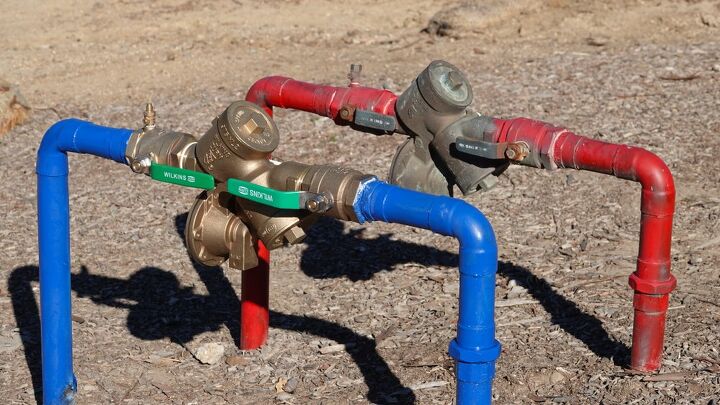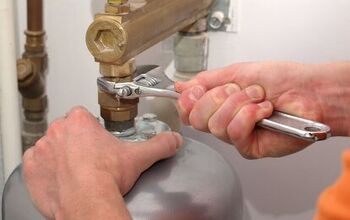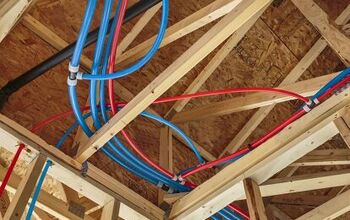Sprinkler Backflow Preventer Leaking? (We Have A Fix)

Backflow preventers are standard parts of irrigation systems installations. Negative pressure in the water system could pull contaminated water back into your drinking water supply. What is the remedy for a sprinkler backflow preventer that is leaking?
Backflow preventers may drip water occasionally as a normal part of their operation. However, a steady drip from a backflow preventer is not normal. Backflow preventers can leak from the pipe joint connections, from the backflow preventer valve assembly, or the body of the valve may have cracked.
Diagnosing and repairing a leaking backflow preventer can be as easy as replacing the washer in the female connections or may require disassembling the valve to clean or replace worn parts. These maintenance and repairs are usually easily accomplished by a homeowner. Following a few simple steps can lead you to a successful fix.
Do You Need to Hire a Sprinkler System Contractor?
Get free, zero-commitment quotes from pro contractors near you.

Finding the Problem
Finding the source of the problem can be the biggest challenge. If the leak is intermittent, it could be a part of the backflow preventer’s normal operation or indicate more serious problems.
Backflow preventers will often leak a small amount of water from the weep holes in the valve. This intermittent leaking usually occurs when the irrigation system shuts down. IF another appliance in the home like a washing machine or dishwasher causes a sudden drop in water pressure,
This sudden drop in water pressure in your domestic water system causes the backflow preventer to operate as designed. However, if the water is constantly dripping from the weep hole in the valve’s body, you must find and repair the cause of this constant drip.
Leaks from Fittings
You should promptly attend to leaks around fittings on the backflow preventer to prevent further damage to the backflow preventer valve. Worn or cracked gaskets or washers are the usual culprits when water leaks around these fittings.
Leaks from Cracks or Damage
If you can see a visible crack or other damage to the backflow preventer’s body, it may be time to call your plumber o irrigation repair technician. If the weep holes in the backflow preventer clog and water can remain in the valve over winter. Frozen water in the valve can damage the internal components or crack the valve body.
Replacing a broken or damaged backflow preventer valve is a job for a licensed plumber or an irrigation technician. Any repair to a valve connecting to a domestic water supply requires a licensed technician in most jurisdictions.
Stopping the Leak
After you determine the leak location, you can often easily remedy the problem. Following these simple steps can have your backflow preventer operating as designed in no time.
Step 1 – Gather the Materials and Supplies
You must know the make and model of your backflow preventer. With this information, your local irrigation parts supplier can give you the correct repair kits and parts to rebuild your backflow preventer. Once you have the correct parts, you are ready to proceed.
Step 2 – Tools and Equipment
The tools you need are relatively simple.
- A set of medium-sized channel lock pliers
- Both straight and Phillips head screwdrivers
- Safety glasses
- A set of small wrenches (if the bell cover of your ball valve is held in place by bolts rather than screws)
Step 3 – Turn off the Water
There may be a ball valve in the water supply line between your backflow preventer and the water supply connection. This valve is often placed just ahead of the backflow preventer to make repairs and maintenance on the irrigation system easier.
If there is no ball valve, you must turn off the main water supply valve on your house’s water supply line. Open the lowest drain on your irrigation system and manually open all the irrigation system valves to drain any remaining water from the system lines.
Step 3 – Repair the Backflow Preventer Valve
Opening the valve to repair the internal parts may differ from manufacturer to manufacturer. The repair kit you received will have instructions on the disassembly and the re-assembly of the backflow preventer. Follow the directions precisely to rebuild the backflow preventer.
Step 4 – Replacing Gaskets and O-rings
The repair kit may also contain new gaskets, washers, or O-rings for the various connections to the water supply and the irrigation distribution lines. Over time, these parts can ear or deteriorate from age. Follow the backflow preventer manufacturer’s recommendations on replacing these parts.
Step 5 – Re-assemble the Backflow Preventer
Reassemble the backflow preventer making sure that you keep any debris or dirt out of the open valve. Be careful not to overtighten the nuts or screws holding the top of the valve in place. You can easily damage the backflow preventer body by overtightening these bolts or screws.
Step 6 – Turn the Water On
Slowly turn on the water feeding the irrigation system. If you have used the main water supply valve, proceed slowly. Opening the valve suddenly can cause a water hammer damaging other parts of your plumbing system. Allow water to fill the irrigation lines slowly. You may hear the air escaping from the irrigation heads or the drain valve.
Close the drain valves and operating valves on your irrigation system. Check the repaired backflow preventer for leaks. If the backflow preventer is still leaking, you may have internal damage to the valve body. In this case, a call to a plumber or irrigation technician is in order.
What Does a Backflow Preventer Do?
Think of a turnstile in a subway station or at the amusement park. The turnstile only allows people to come through a fence in one direction. A backflow preventer does much the same job in your irrigation system.
One of the dangers of feeding an irrigation system from your domestic water supply is contamination. If your domestic water supply experiences a sudden pressure drop, water can flow backward. A backward flow of water would draw possibly contaminated water from the irrigation system into your drinking water supply.
A backflow preventer senses this sudden pressure differential and stops the backward flow of water. The backflow preventer protects not only your water system but the entire water supply system from contamination.
How Does A Backflow Preventer Work?
Most irrigation system backflow preventers are simple in their design. An internal valve opens when water flows through the valve in the proper direction. In an irrigation system, the flow is from the water supply to the irrigation heads.
If the water flow reverses direction for any reason, the valve in the backflow preventer closes and stops the flow of water. In most irrigation system backflow preventers, this valve is spring operated. Over time the valve and its parts can suffer wear and damage or become clogged with debris that can keep the valve from operating.
Does Law Require Backflow Preventers?
Most jurisdictions with a community water system require a backflow preventer on residential irrigation systems. In many states, a licensed plumber or a state-certified irrigation technician must install the backflow preventer. In some places, the codes require regular testing of the backflow preventer by a certified technician.
Your local water utility or code enforcement department will have information about installation requirements and testing requirements for your residential irrigation system.
Can I Install or Repair a Backflow Preventer Myself?
Many places allow a homeowner to work on their home that would otherwise require a licensed electrician or plumber. Check with your local building inspection department. You may need a permit to do the work even if you do it yourself. If a permit is required, you will probably be required to have the work inspected as well.
Do You Need to Hire a Sprinkler System Contractor?
Get free, zero-commitment quotes from pro contractors near you.

Keeping Things Flowing in the Right Direction
The object of your backflow preventer is to keep the water flowing in the right direction. If your backflow preventer is leaking, you have a problem. That problem may mean the backflow preventer is not working properly. A non-working backflow preventer can be dangerous to you and your family’s health.
We hope that the information about backflow preventers in this article is helpful. If your backflow preventer is leaking, take care of the problem right away. With this article’s help, you can find and repair most of the problems with leaking backflow preventers. Good luck and work safely.

Dennis is a retired firefighter with an extensive background in construction, home improvement, and remodeling. He worked in the trades part-time while serving as an active firefighter. On his retirement, he started a remodeling and home repair business, which he ran for several years.
More by Dennis Howard



























